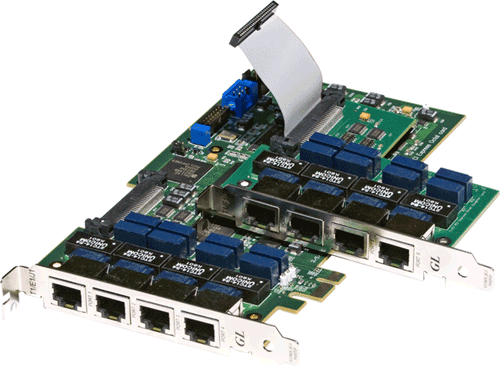Linux and MS-Windows Drivers & APIs for Custom Development of T1 E1 Applications
10th, Nov 2017
Welcome to another November 2017 issue of GL Communications’ Newsletter providing information and insight into our latest Linux and MS-Windows Drivers & API Support for custom development of T1 E1 Application on GL’s Quad and Octal Analysis & Emulation Hardware.
Overview
Open source is ubiquitous, it's almost unavoidable and Linux is the leader in open source. So GL is developing Linux drivers and Application Programming Interfaces (APIs) for our flagship products! Since our cards have unique features unavailable with other industry standard cards, customers can now build custom applications faster and cheaper. Recently we have developed drivers and APIs for our T1 E1 Quad and Octal Analysis & Emulation Hardware.
All of the functionality of the hardware is exposed through the API. In addition, many software based functions are available that ease even the most complex application development.
GL's Octal & Quad T1 E1 boards are high-density boards that provide Four (4) or Eight (8) RJ-48 T1 E1 ports and multiples thereof. For example, configurations of 8, 12, 16,…64 T1 E1s in a single rack are possible.
Details of Linux and MS-Windows APIs and Drivers
GL’s T1 E1 Application Development Toolkit is an API library that provides functions to access a wealth of GL Communications’ T1 E1 features. The toolkit consists of:
- Device Driver
- API library implemented as a DLL/Shared Object
- Header and import library files
- API Reference Guide
- Sample code
The Application Development Toolkit can be used to develop new applications using
GL Communications’ T1 E1 cards. The toolkit supports Linux and MS-Windows operating systems and provides C++ class library to access hardware features.
Having ported our "GLComIFC" from Windows to Linux, the driver and API expose all features of the hardware for T1 E1 Cards. An API Toolkit provides examples how to access the Raw Data, Set / Reset Registers, Set Clocking Modes, Get / Set Alarms, Loopbacks.
Important T1 E1 Quad and Octal Analysis & Emulation Hardware Applications / Features
- Software Selectable T1 or E1 interfacing along with Drop and Insert
- PCI Express x1 Lane/Board, compliant to PCI Express Base Specification v1.1
- Monitor the T1 E1 line conditions such as frame errors, violations, alarms, frequency, power level, and clock (or frame/bit) slips
- High Density and High Speed – The boards (with Direct Memory Access) are significantly faster and more efficient
- Octal boards are compatible with dual, quad, and higher core motherboards and software that simulate dual and quad cores (hyper-threading)
- T1 systems support the framing formats: 193S (D4) Framing Format and 193E (ESF) Framing Format
- E1 systems support the framing formats: Channel Associated (CAS), Common Channel Signaling (CCS), and Unframed Mode for E1
- Clock Options: With internal clock option the transmit section is clocked using an internal oscillator. For recovered clock option the transmit section is clocked using the clock derived from the received signal. If no received signal is present the internal clock is used. An external clock can be provided at the SMB input of the Cards or Dual USB Units
- Loop-backs: Cross-port Through, and Cross-port Transmit modes
- Windows and Linux Drivers for Open Source Applications


 Back to Newsletter Index Page
Back to Newsletter Index Page